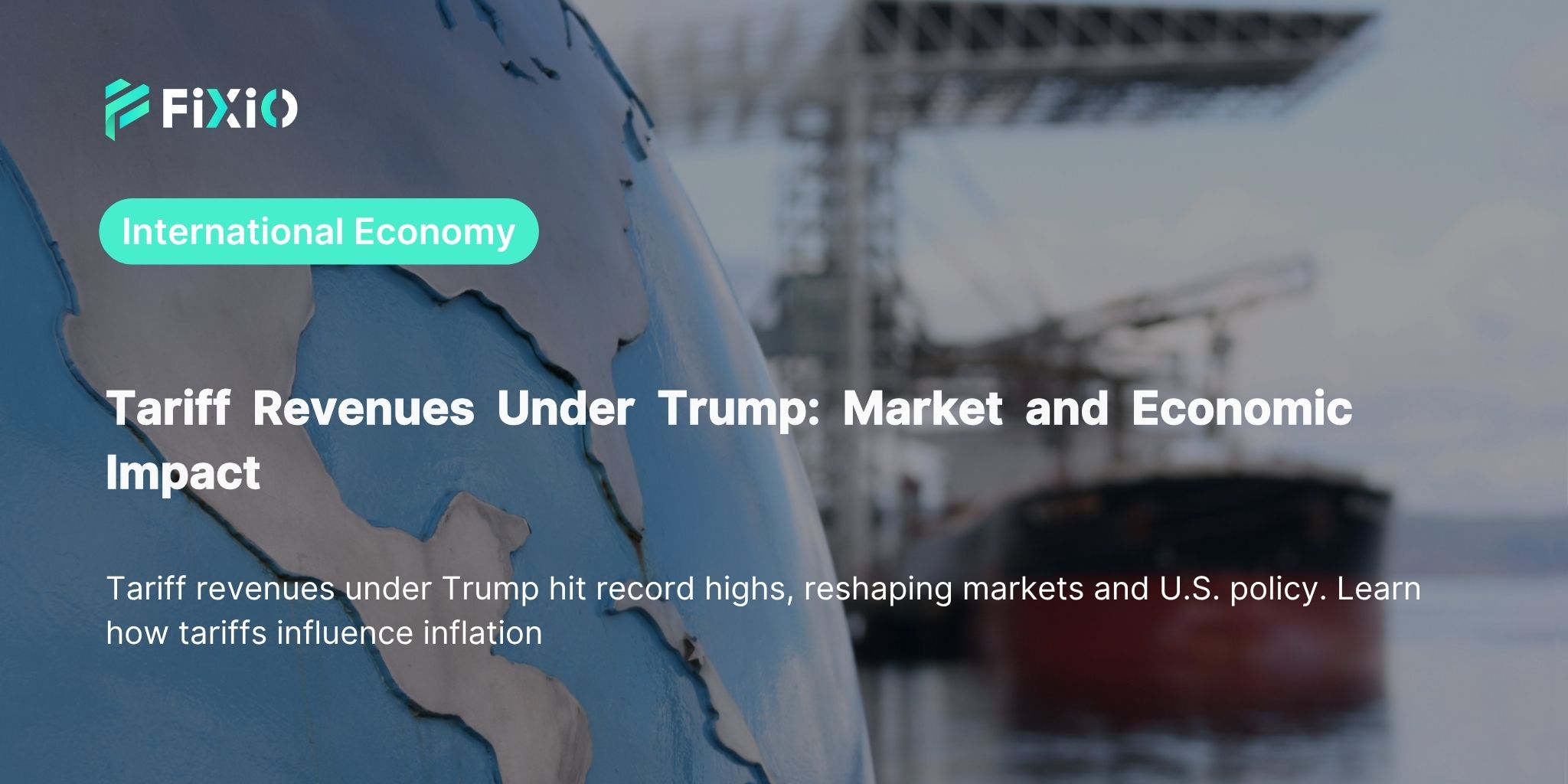
Introduction
The rise in
tariff revenues has once again taken center stage in U.S. politics and global markets. President Donald Trump’s
tariff policies have generated record levels of revenue for the government. Yet, even as the Treasury collects billions, the ongoing political deadlock and government shutdown highlight the limitations of using such revenue to stabilize the economy. For traders and investors, understanding the broader economic and market implications of
tariff revenues is vital to navigating volatility and anticipating shifts in fiscal and monetary policy.
Understanding Tariffs and Their Role in Global Trade
A tariff is a tax imposed on imported goods to protect domestic industries or raise government revenue. Historically, tariffs have been a cornerstone of trade policy across major economies. They influence supply chains, inflation, and consumer prices, while also serving as tools of economic diplomacy.
When tariffs increase, imported goods become more expensive. This can encourage local production but also raise costs for manufacturers reliant on foreign components. The result is a chain reaction that can affect inflation data, consumer spending, and even decisions made by the Federal Reserve.
Record Tariff Revenues and Fiscal Paradox
According to the U.S. Treasury Department, the government collected roughly $190 billion in tariff revenues over the past year — a staggering 160% increase from the previous year. On the first day of the government shutdown, tariff collections reached $315 million. Despite these record-breaking figures, the funds remain trapped in the Treasury’s general account, frozen until lawmakers approve a new spending bill.
This paradox highlights an essential truth for financial markets: strong tariff revenues do not equal fiscal flexibility. The federal government cannot allocate these funds freely during a shutdown. As a result, despite healthy inflows, fiscal liquidity remains constrained — limiting spending on public services, contracts, and salaries.
Economic Impact of Tariff Revenues: A Double-Edged Sword
While tariffs can boost short-term revenue, they often act as hidden taxes on businesses and consumers. Increased import costs trickle down into retail prices, adding upward pressure to inflation. This dynamic complicates the Federal Open Market Committee’s decision-making, potentially leading to higher interest rates and a stronger U.S. dollar.
For traders, this creates an interesting contrast: tariff revenues may support the dollar temporarily due to higher inflation expectations, but persistent trade tensions can dampen business investment and consumer confidence, leading to slower growth over time.
How Markets React to Tariff Revenues Announcements
Each time new tariff revenues policies are introduced or expanded, markets respond with volatility. Equity indices such as the S&P 500 and Nasdaq 100 often see short-term declines in export-dependent sectors, particularly manufacturing, technology, and agriculture. Meanwhile, commodity markets like gold tend to rise as investors seek safe-haven assets.
However, domestic industries that compete with imported goods may benefit temporarily from reduced foreign competition. Over time, though, rising input costs and retaliatory trade measures often erase these advantages.
Tariff Revenues and Inflation: A Hidden Relationship
One of the least understood consequences of tariff revenues is their indirect effect on inflation. By increasing import prices, tariffs push up producer and consumer costs. This inflationary pressure influences bond yields, monetary policy expectations, and the performance of rate-sensitive assets like real estate and utilities.
As inflationary expectations rise, central banks may signal a tighter stance, which can strengthen domestic currencies in the short term. Yet, prolonged inflation without productivity growth eventually weakens purchasing power and slows overall economic expansion.
Investor Perspective: Tariff Revenues as a Market Indicator
For traders, the level of tariff revenues serves as a real-time indicator of geopolitical and fiscal tension. Increasing tariffs often coincide with risk aversion, leading to capital inflows toward safe assets such as the U.S. dollar, Treasury bonds, and gold. Conversely, when tariff policies ease or trade agreements progress, risk-on sentiment tends to lift global equities and emerging market currencies.
Monitoring trade data, Treasury statements, and political commentary allows investors to gauge the direction of market sentiment and adapt their portfolios accordingly. A spike in tariff revenues can foreshadow higher volatility, especially in currencies tied to global trade, such as the Chinese yuan, Japanese yen, and euro.
Political Gridlock and Fiscal Strategy
Despite the record inflows, both political parties in Washington remain divided on how to use tariff revenues. Supporters argue that tariffs are a tool of economic sovereignty, helping to reduce dependency on foreign supply chains. Critics, however, view them as consumer taxes that raise costs for everyday Americans while providing minimal long-term fiscal benefit.
Even if Congress agreed to redirect tariff funds during a shutdown, the impact would be limited. Federal spending on defense, infrastructure, and healthcare far exceeds tariff revenues, meaning such revenue cannot meaningfully offset the shortfall caused by political stalemates.
Global Ripple Effects of U.S. Tariff Revenues Policy
Other major economies are not standing still. China, the European Union, and Canada have all implemented counter-tariffs, intensifying the trade war environment. These retaliatory measures disrupt global supply chains, influence corporate relocation strategies, and shift foreign direct investment patterns.
Emerging markets such as Vietnam and Indonesia have benefited as multinational companies seek to diversify manufacturing away from high-tariff regions. For traders, this geographic rebalancing opens new opportunities — from foreign exchange plays in Southeast Asia to commodity hedging in logistics and transport sectors.
How Tariff Revenues Affect Currencies and Commodities
Currency markets respond quickly to tariff revenues-related developments. When tariffs expand, the U.S. dollar often strengthens initially due to global risk aversion. However, prolonged trade tension can lead to slower economic growth, causing the dollar to lose momentum over time. Commodity markets mirror this pattern: industrial metals like copper decline on lower manufacturing demand, while gold and silver gain from safe-haven flows.
Understanding this inverse correlation helps traders balance portfolios through hedging strategies — for example, going long on gold or the Japanese yen during tariff escalations while shorting trade-sensitive equities.
Long-Term Implications for Investors
Tariff revenues are likely to remain a recurring feature of international trade. The broader shift toward protectionism suggests that investors must adapt to an era where geopolitical policy shapes market sentiment more than traditional fundamentals. Long-term portfolio management should therefore include exposure to industries and regions less vulnerable to cross-border disruptions.
Traders should also monitor changes in fiscal and monetary policies linked to tariff revenues. As revenues climb, governments may attempt to justify higher spending or expand subsidies, influencing bond yields and inflation expectations globally.
Conclusion: Lessons from the Tariff Revenues Paradox
Trump’s tariff revenues surge demonstrates how government income and market dynamics can move in opposite directions. Despite the increase in collections, political gridlock prevents the money from being used effectively, leaving the economy vulnerable to fiscal shocks. For investors, this highlights a crucial insight: it is not the size of the tariff revenues that matters, but how it fits into the broader framework of fiscal stability, inflation control, and international trade balance.
Ultimately, the tariff revenues story is a reminder that markets react less to numbers and more to confidence — in governance, policy direction, and global cooperation. Traders who understand this relationship will be better positioned to navigate uncertainty and capitalize on opportunities created by economic realignments.
Stay informed with the latest Forex trading news and analysis. Visit our website now at:
https://fixiomarkets.com/en/prex-blogs
Tariff revenues under Trump hit record highs, reshaping markets and U.S. policy. Learn how tariffs influence inflation
Forex Trading Broker Banner
Superior trade execution & trading conditions with the NDD method.
David Wilson
Author
David Wilson has extensive experience in currency and commodities trading. He began his career in metal sales and trading at Societe Generale in London. He went on to work as a senior analyst within the FX industry where he developed and refined his own trading and risk management strategies. Having a solid understanding of market dynamics, he founded his own research and asset management services and works with FIXIO to provide timely market commentary on the global financial markets.



Comment (0)